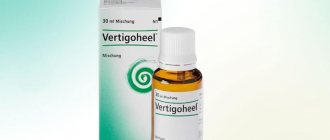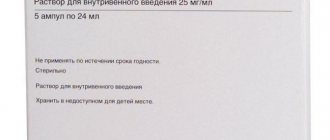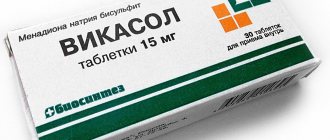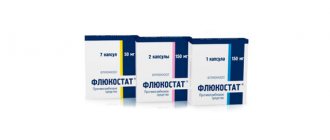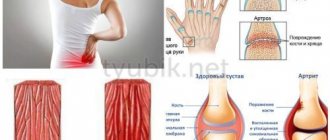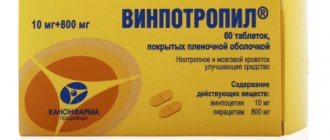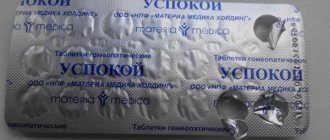Release form and composition
The drug is produced in the form of tablets: flat-cylindrical, with a score and a chamfer on one side; 1.75 mg each - pale pink, 3.5 and 5 mg - pink (120 pieces each in colorless glass bottles, 1 bottle in a cardboard box and instructions for use of Maninil).
1 tablet contains:
- Active substance: glibenclamide – 1.75, 3.5 or 5 mg (in micronized form);
- Auxiliary components (1.75/3.5/5 mg each, respectively): lactose monohydrate – 68.99967/63.9967/90 mg, potato starch – 26/27.75/48.697 mg, hymetellose – 11/11/0 mg, colloidal silicon dioxide – 2/3.5/0 mg, magnesium stearate – 0.25/0.25/1.5 mg, talc – 0/0/2.25 mg, gelatin – 0/0/2, 55 mg, crimson dye (Ponceau 4R) (E124) – 0.00033/0.0033/0.003 mg.
Analogs of Maninila
Level 4 ATC code matches:
Gliclazide
Glidiab
Glyurenorm
Glimepiride
Amyx
Glibenclamide
Amaryl
Diabetes
Analogs include Glibamide and Glibenclamide .
Pharmacological properties
Pharmacodynamics
Maninil is an oral hypoglycemic drug from the group of sulfonylurea derivatives of the second generation.
The use of glibenclamide helps stimulate insulin secretion, which occurs due to its binding to specific membrane receptors of pancreatic β-cells. Also, while taking the drug, there is an increase in insulin release, a decrease in the threshold for irritation of pancreatic β-cells by glucose, an increase in sensitivity to insulin and the degree of its binding to target cells, an increase in the effect of insulin on the absorption of glucose by the liver and muscles, which leads to a decrease in the concentration of glucose in blood. The action develops in the second stage of insulin secretion. Reduces the thrombogenic properties of blood, has a hypolipidemic effect, and inhibits lipolysis in adipose tissue.
Maninil in a dose of 1.75 and 3.5 mg in micronized form is a high-tech, specially crushed form of glibenclamide, allowing the substance to be absorbed more quickly from the gastrointestinal tract. Due to the earlier achievement of Cmax (maximum concentration of the substance) of glibenclamide in plasma, the hypoglycemic effect in time practically corresponds to the rise in blood glucose concentration after a meal. This property makes the influence of Maninil more physiological and mild. The duration of the hypoglycemic effect ranges from 20 to 24 hours.
The hypoglycemic effect of the drug at a dose of 5 mg develops in 2 hours, its duration is 12 hours.
Pharmacokinetics
Suction:
- Maninil 3.5 and 1.75: absorption from the gastrointestinal tract is rapid and almost complete. The full release of the micronized active substance occurs in 5 minutes;
- Maninil 5: degree of absorption from the gastrointestinal tract – from 48 to 84%. The time to reach Cmax is 1–2 hours. Absolute bioavailability ranges from 49 to 59%.
Plasma protein binding: Maninil 3.5 and 1.75 – more than 98%, Maninil 5 – 95%.
Glibenclamide is almost completely metabolized in the liver, with the formation of two inactive metabolites. One of them is excreted in bile, the second in urine.
T1/2 (half-life): Maninil 1.75 and 3.5 – 1.5–3.5 hours, Maninil 5 – from 3 to 16 hours.
Maninila price, where to buy
The price of Maninil 1.75 is 130 rubles per package of 120 tablets.
The cost of Maninil is 3.5 - 170 rubles for the same packaging.
Maninil 5 will also cost about 130 rubles for 120 tablets.
- Online pharmacies in RussiaRussia
- Online pharmacies in UkraineUkraine
- Online pharmacies in KazakhstanKazakhstan
ZdravCity
- Maninil 1.75 tablets 1.75 mg 120 pcs. Berlin-Chemie AG/Menarini Group
112 rub. order - Maninil 5 tablets 5 mg 120 pcs. Berlin-Chemie AG
117 RUR order
Pharmacy Dialogue
- Maninil (tab. 1.75 mg No. 120) Berlin-Chemie AG/Menarini
117 RUR order
- Maninil (5 mg tablet No. 120)Berlin-Chemie AG/Menarini
113 RUR order
- Maninil (tab. 3.5 mg No. 120) Berlin-Chemie AG/Menarini
RUB 151 order
show more
Pharmacy24
- Maninil 5 mg No. 120 tablets Berlin Chemi AG, Nimechchina
89 UAH.order - Maninil 3.5 mg No. 120 tablets Menarine von Heyden GmbH/Berlin Chemie AG (Menarine Group), Nimecchina/Nimecchina
93 UAH order
PaniPharmacy
- Maninil tab. 3.5 mg No. 120 Germany, Berlin-Chemie
105 UAH order
- Maninil tab. 5mg No. 120 Germany, Berlin-Chemie
94 UAH order
show more
Contraindications
- Diabetes mellitus type 1;
- Leukopenia;
- Diabetic coma and precoma, diabetic ketoacidosis;
- Condition after removal of the pancreas;
- Severe liver and kidney failure (with creatinine clearance less than 30 ml per minute);
- Gastric paresis, intestinal obstruction;
- Decompensation of carbohydrate metabolism in infectious diseases, injuries, burns, or after major surgical operations, when insulin therapy is indicated;
- Glucose-6-phosphate dehydrogenase deficiency;
- Hereditary lactose intolerance, lactase deficiency or lactose and glucose malabsorption syndrome;
- Age up to 18 years (the effectiveness and safety of Maninil in this age group of patients have not been studied);
- Pregnancy and breastfeeding (lactation);
- Hypersensitivity to the components of the drug, as well as to other sulfonylurea derivatives, sulfonamides, probenecid, diuretics (diuretics) containing a sulfonamide group in the molecule (due to the possibility of cross-reactions).
Maninil should be taken with caution by patients with acute alcohol intoxication, chronic alcoholism, febrile syndrome, thyroid disease (with dysfunction), hypofunction of the adrenal cortex or anterior pituitary gland, as well as patients over 70 years of age (due to the risk of hypoglycemia).
Indications for use
Prescribed in the treatment of type 2 insulin-dependent diabetes mellitus. Taking medication is necessary when it is not possible to normalize glucose concentrations through diet and exercise. In the treatment of diabetes, the drug is prescribed in complex therapy with other hypoglycemic agents, except glinides and sulfonylurea derivatives.
The drug is prescribed for the treatment of type 2 insulin-dependent diabetes mellitus.
Maninil, instructions for use: method and dosage
Maninil tablets are taken orally, without chewing and with a small amount of liquid, preferably before meals. If the daily dose is 1-2 tablets, it is taken once in the morning, immediately before breakfast. Higher doses should be taken in 2 divided doses (morning and evening).
If you accidentally miss one dose of Maninil, the next tablet should be taken at the usual time, without increasing the dose.
The drug dosage regimen is determined by age, severity of the disease, blood glucose concentration on an empty stomach and 2 hours after a meal.
If the prescribed initial dose is insufficiently effective, under medical supervision it is gradually (from several days to 1 week) increased until it is sufficient to stabilize carbohydrate metabolism (but not higher than the maximum).
When switching from taking other hypoglycemic drugs, Maninil is prescribed in the usual initial dose under medical supervision with a gradual increase to the optimal dose.
The daily dose (initial/maximum) is:
- Maninil 1.75: 1.75-3.5/10.5 mg (if the daily dose is higher than 3 tablets, the use of Maninil 3.5 is recommended);
- Maninil 3.5: 1.75-3.5/10.5 mg;
- Maninil 5: 2.5-5/15 mg.
Due to the risk of developing hypoglycemia in elderly patients, with severe functional disorders of the liver or kidneys, weakened patients and patients with poor nutrition, the initial and maintenance doses of Maninil should be reduced.
Reception scheme
During administration, the tablet should be swallowed whole or broken into 2 parts, but not chewed. It is drunk twice a day - in the morning and evening. The endocrinologist selects the dose. Self-prescription of Maninil is unacceptable, since incorrect dosage can provoke the development of side effects. After taking the drug, you need to eat so that your blood sugar level does not drop to critical levels.
If Maninil in the dosage prescribed by the doctor has ceased to have the desired effect, then it cannot be increased. You need to see a doctor. Most likely, you will need to switch to insulin injections.
Side effects
During the use of Maninil, it is possible to develop disorders of certain body systems (>1/100, 1/1000, 1/10,000, <1/1000 - rare, <1/10,000, including isolated cases - very rare):
- Digestive system: uncommon – feeling of heaviness in the stomach, nausea, abdominal pain, belching, vomiting, metallic taste in the mouth, diarrhea;
- Immune system: uncommon – purpura, itching, urticaria, increased photosensitivity, petechiae; very rarely - generalized allergic reactions, accompanied by arthralgia, skin rash, fever, jaundice and proteinuria; anaphylactic shock, allergic vasculitis;
- Hematopoietic system: rarely - thrombocytopenia; very rarely - agranulocytosis, erythropenia, leukopenia; in isolated cases - hemolytic anemia, pancytopenia;
- Liver and biliary tract: very rarely - intrahepatic cholestasis, short-term increase in the activity of liver enzymes, hepatitis;
- Metabolism: often - hypoglycemia (in the form of hunger, tremor, hyperthermia, tachycardia, drowsiness, weakness, headache, wetness of the skin, impaired coordination of movements, general anxiety, feelings of fear, transient neurological disorders, including speech disorders, the appearance of paralysis or paresis or altered perception of sensations); weight gain;
- Other: very rarely - accommodation disorders and visual impairment, increased diuresis, hyponatremia, transient proteinuria, disulfiram-like reaction when taking alcohol (the most common signs of the effect include: vomiting, nausea, abdominal pain, tachycardia, a feeling of heat in the upper body and facial skin , headache, dizziness), cross-allergy to probenecid, sulfonamides, sulfonylurea derivatives, diuretics (diuretics) containing a sulfonamide group in the molecule.
Overdose
Main symptoms: hypoglycemia, which manifests itself in the form of hunger, hyperthermia, tachycardia, drowsiness, weakness, wetness of the skin, impaired coordination of movements, general anxiety, tremor, headache, feelings of fear, transient neurological disorders (for example, speech and vision disorders , manifestations of paralysis or paresis, or changes in the perception of sensations). As hypoglycemia progresses, loss of consciousness and self-control and the development of hypoglycemic coma may occur.
Therapy:
- mild hypoglycemia: the patient needs to take a piece of sugar, drinks or food high in sugar (honey, jam, a glass of sweet tea);
- loss of consciousness: intravenous administration of glucose (from 40 to 80 ml of 40% dextrose solution), then infusion of 5–10% dextrose solution. Additionally, 1 mg of glucagon can be administered (intravenously, intramuscularly or subcutaneously). If the patient does not regain consciousness, this measure can be repeated; in some cases intensive therapy is required.
Overdose of the drug Maninil, symptoms and treatment
Acute and chronic overdose of glibenclamide can cause the development of severe, prolonged and life-threatening hypoglycemia. Hypoglycemia can develop due to skipping meals, increased physical activity, and drug interactions. Symptoms of hypoglycemia: severe feeling of hunger, nausea, vomiting, general weakness, anxiety, hyperhidrosis, tachycardia, tremor, mydriasis, muscle hypertonicity, headache, sleep disturbances, endocrine psychosyndrome (irritability, aggressiveness, depression, depression, impaired concentration, confusion , coordination disorders, primitive automatisms - grimacing, grasping movements, chomping, convulsions, focal symptoms - hemiplegia, aphasia, diplopia, drowsiness, coma, disturbance of the central regulation of breathing and activity of the cardiovascular system). As hypoglycemia progresses, loss of consciousness (hypoglycemic coma) is possible; characterized by wet and cold skin upon palpation, tachycardia, hyperthermia, motor agitation, hyperreflexia, the appearance of a positive Babinski reflex and the development of paresis and convulsions. Treatment. Mild hypoglycemia (without loss of consciousness) can be eliminated by the patient on his own by taking approximately 20 g of glucose, sugar or carbohydrate-rich food. In case of accidental overdose and in the presence of contact with the patient, it is necessary to induce vomiting, perform gastric lavage (in the absence of convulsive readiness), prescribe adsorbents and administer intravenous glucose solution. In case of severe hypoglycemia (with loss of consciousness), it is necessary to immediately catheterize the vein. 40–100 ml of 40% glucose solution is administered intravenously as a bolus, followed by an infusion of 5–10% glucose solution, and if venous catheterization is impossible, 1–2 mg of glucagon is administered intramuscularly or subcutaneously. If the patient does not regain consciousness, the above measures are repeated and, if necessary, intensive therapy is carried out. To prevent relapses of hypoglycemia after restoration of consciousness over the next 24–48 hours, carbohydrates are prescribed orally (20–30 g immediately and every 2–3 hours) or a prolonged intravenous infusion of 5–20% glucose solution is performed. You can administer 1 mg of glucagon IM every 6 hours for 48 hours. Carry out regular monitoring of glycemic levels for at least 48 hours after elimination of a severe hypoglycemic state. If, in the event of a significant overdose (for example, during suicidal attempts), consciousness is not restored, a continuous infusion of 5–10% glucose solution is performed, the desired plasma glucose concentration is approximately 200 mg/dL. After 20 minutes, a re-infusion of 40% glucose solution is possible. If the clinical picture does not change, it is necessary to carry out a differential diagnosis of coma and simultaneously treat cerebral edema (dexamethasone, sorbitol). Glibenclamide is not excreted from the body during hemodialysis.
special instructions
When using Maninil, you must strictly adhere to your doctor's instructions regarding self-monitoring of blood glucose concentrations and diet.
With prolonged abstinence from eating, insufficient supply of carbohydrates to the body, intense physical activity, diarrhea or vomiting, the risk of developing hypoglycemia increases.
Concomitant use of Maninil with drugs that act on the central nervous system, lowering blood pressure, including beta-blockers, as well as peripheral neuropathy can mask the signs of hypoglycemia.
In elderly patients, the risk of hypoglycemia is slightly higher, and therefore they need more careful dose selection and regular monitoring of fasting and postprandial blood glucose concentrations, especially at the beginning of drug use.
Alcohol increases the risk of hypoglycemia and a disulfiram-like reaction; for this reason, it is recommended not to take it during treatment.
Extensive burns, injuries and major surgical interventions, infectious diseases with febrile syndrome may cause Maninil to be discontinued and insulin prescribed.
Prolonged exposure to the sun during therapy is not recommended.
Impact on the ability to drive vehicles and complex mechanisms
When using Maninil, patients must be careful when driving vehicles and performing other potentially dangerous work that requires increased attention and rapid psychomotor reactions.
Reviews
Patients indicate that Maninil is an affordable medicine. Therefore, the choice often falls on him.
You can find reviews that after a few years from the start of taking Maninil, it stops working. However, there are also positive reviews about this medicine.
Author of the article:
Alekseeva Maria Yurievna |
Therapist Education: From 2010 to 2021 practicing physician at the therapeutic hospital of the central medical unit No. 21, the city of Elektrostal. Since 2021 he has been working at diagnostic center No. 3. Our authors
Drug interactions
When Maninil is used simultaneously with certain medications, the following effects may occur:
- Angiotensin-converting enzyme inhibitors, non-steroidal anti-inflammatory drugs, anabolic drugs and male sex hormones, insulin and other oral hypoglycemic agents (for example, biguanides, acarbose), azapropazone, beta-blockers, quinolone and coumarin derivatives, chloramphenicol, clofibrate and its analogs, fenfluramine, disopyramide , antifungal drugs (miconazole, fluconazole), fluoxetine, monoamine oxidase inhibitors, para-aminosalicylic acid, pentoxifylline (in high doses when administered parenterally), perhexiline, pyrazolone derivatives, phosphamides (for example, ifosfamide, cyclophosphamide, trofosfamide), salicylates, probenecid, sulfonamides, tritoqualine and tetracyclines: increased hypoglycemic effect of Maninil;
- Barbiturates, isoniazid, diazoxide, glucocorticosteroids, glucagon, nicotinates (in high doses), phenytoin, phenothiazines, rifampicin, thiazide diuretics, acetazolamide, oral contraceptives and estrogens, thyroid hormone preparations, sympathomimetic agents, slow calcium channel blockers, lithium salts: decreased hypoglycemic action of Maninil;
- Clonidine, beta-blockers, reserpine and guanethidine, as well as drugs with a central mechanism of action: weakening the sensation of warning signs of hypoglycemia;
- H2 receptor antagonists: strengthening or weakening of the hypoglycemic effect of Maninil;
- Coumarin derivatives: strengthening or weakening of their action;
- Drugs that acidify urine (ammonium chloride, calcium chloride): increased action of Maninil;
- Pentamidine: strong increase or decrease in blood glucose concentration (in isolated cases).
Instructions:
Clinical and pharmacological group
15.014 (Oral hypoglycemic drug)
Release form, composition and packaging
Maninil® 1.75
The tablets are pale pink, round, flat on both sides, with beveled edges, scored on one side.
| 1 tab. | |
| glibenclamide (micronized form) | 1.75 mg |
Excipients: lactose monohydrate, potato starch, methylhydroxyethylcellulose, precipitated silicon dioxide, magnesium stearate, cochineal red A (dye E124).
120 pcs. — colorless glass bottles (1) — cardboard packs.
Maninil® 3.5
The tablets are pink, round, flat on both sides, with beveled edges, and scored on one side.
| 1 tab. | |
| glibenclamide (micronized form) | 3.5 mg |
Excipients: lactose monohydrate, potato starch, methylhydroxyethylcellulose, precipitated silicon dioxide, magnesium stearate, cochineal red A (dye E124).
120 pcs. — colorless glass bottles (1) — cardboard packs.
Maninil® 5
The tablets are pink, round, flat on both sides, with beveled edges and a one-sided score.
| 1 tab. | |
| glibenclamide | 5 mg |
Excipients: lactose monohydrate, potato starch, magnesium stearate, talc, gelatin, crimson dye (Ponceau 4R).
120 pcs. — colorless glass bottles (1) — cardboard packs.
pharmachologic effect
An oral hypoglycemic drug from the group of sulfonylurea derivatives of the second generation.
Stimulates insulin secretion by binding to specific membrane receptors of the pancreatic β-cell, reduces the threshold of glucose irritation of pancreatic β-cells, increases sensitivity to insulin and the degree of its binding to target cells, increases insulin release, enhances the effect of insulin on glucose uptake by muscles and liver, thereby reducing the concentration of glucose in the blood. Acts in the second stage of insulin secretion. Inhibits lipolysis in adipose tissue. It has a hypolipidemic effect, reduces the thrombogenic properties of blood.
Maninil® 1.5 and Maninil® 3.5 in micronized form are a high-tech, specially crushed form of glibenclamide, which allows the drug to be absorbed more quickly from the gastrointestinal tract. Due to the earlier achievement of Cmax of glibenclamide in plasma, the hypoglycemic effect practically corresponds in time to the rise in blood glucose concentration after a meal, which makes the effect of the drug milder and physiological. The duration of the hypoglycemic effect is 20-24 hours.
The hypoglycemic effect of the drug Maninil® 5 develops after 2 hours and lasts 12 hours.
Pharmacokinetics
Suction
After oral administration of Maninil 1.75 and Maninil 3.5, rapid and almost complete absorption from the gastrointestinal tract is observed. Complete release of the microionized active substance occurs within 5 minutes.
After oral administration of Maninil 5, absorption from the gastrointestinal tract is 48-84%. Tmax - 1-2 hours. Absolute bioavailability - 49-59%.
Distribution
Plasma protein binding is more than 98% for Maninil 1.75 and Maninil 3.5, 95% for Maninil 5.
Metabolism and excretion
Almost completely metabolized in the liver with the formation of two inactive metabolites, one of which is excreted by the kidneys and the other by the bile.
T1/2 for Maninil 1.75 and Maninil 3.5 is 1.5-3.5 hours, for Maninil 5 - 3-16 hours.
Dosage
The doctor sets the dose of the drug individually based on the concentration of glucose in the blood on an empty stomach and 2 hours after a meal.
The initial dose of Maninil® 1.75 is 1/2-1 tablet. 1 time/day If there is insufficient effectiveness, under the supervision of a physician, the dose of the drug is gradually increased until the daily dose necessary to stabilize carbohydrate metabolism is reached. The average daily dose is 2 tablets. (3.5 mg). The maximum daily dose is 3 tablets. (in exceptional cases - 4 tablets).
If it is necessary to take higher doses, switch to taking the drug Maninil® 3.5.
The initial dose of Maninil® 3.5 is 1/2-1 tablet. 1 time/day If there is insufficient effectiveness, under the supervision of a physician, the dose of the drug is gradually increased until the daily dose necessary to stabilize carbohydrate metabolism is reached. The average daily dose is 3 tablets. (10.5 mg). The maximum daily dose is 4 tablets. (14 mg).
The drug should be taken before meals, without chewing and with a small amount of liquid. Daily doses of the drug, up to 2 tablets, should usually be taken once a day - in the morning, before breakfast. Higher doses are divided into morning and evening doses. If you miss one dose of the drug, the next tablet should be taken at the usual time, but a higher dose is not allowed.
The initial dose of Maninil® 5 is 2.5 mg 1 time/day. If there is insufficient effectiveness, under the supervision of a physician, the dose of the drug is gradually increased by 2.5 mg/day with an interval of 3-5 days until the daily dose necessary to stabilize carbohydrate metabolism is reached. The daily dose is 2.5-15 mg.
Doses of more than 15 mg/day do not increase the severity of the hypoglycemic effect of the drug.
Elderly patients are at risk of developing hypoglycemia, so for them the initial dose should be 1 mg/day, and the maintenance dose should be selected under the supervision of a physician.
The frequency of administration of the drug Maninil® 5 is 1-3 times a day. The drug should be taken 20-30 minutes before meals.
When switching from other hypoglycemic drugs with a similar mechanism of action, Maninil® 5 is prescribed according to the scheme given above, and the previous drug is discontinued. When switching from biguanides, the initial daily dose is 2.5 mg; if necessary, the daily dose is increased every 5-6 days by 2.5 mg until compensation is achieved. In the absence of compensation within 4-6 weeks, it is necessary to decide on combination therapy with insulin.
Overdose
Symptoms: acute overdose of the drug Maninil®, as well as long-term use of the drug in high doses, can cause severe, prolonged hypoglycemia, which in rare cases threatens the patient’s life.
Treatment: mild conditions of hypoglycemia, namely its first precursors, can be eliminated by the patient himself by immediately eating a piece of sugar, jam, honey, drinking a glass of sweet tea or a glucose solution. Therefore, the patient should always have a few pieces of refined sugar or confectionery (sweets) with him. Confectionery products made specifically for diabetics do not help in such situations. If the patient cannot immediately eliminate the symptoms of hypoglycemia, he should immediately call a doctor. In case of disturbance of consciousness, a 40% dextrose solution is administered intravenously, and 1-2 mg of glucagon intramuscularly. After regaining consciousness, the patient must be given food rich in easily digestible carbohydrates (to avoid re-development of hypoglycemia).
Drug interactions
An increase in the hypoglycemic effect of the drug Maninil® should be expected in cases where treatment with ACE inhibitors, anabolic agents, other oral hypoglycemic drugs (for example, acarbose, biguanides) and insulin, azapropazone, beta-blockers, quinine, quinolone derivatives, chloramphenicol, clofibrate is simultaneously carried out. and its analogues, coumarin derivatives, disopyramide, fenfluramine, pheniramidol, fluoxetine, MAO inhibitors, miconazole, PAS, pentoxifylline (in high doses parenterally), perhexiline, pyrazolone derivatives, phenylbutazones, phosphamides (for example, cyclophosphamide, ifosfamide, trophosfamide ), probenecid, salicylates, sulfinpyrazone, sulfonamides, tetracyclines, tritoqualine, for alcohol abuse.
Urine acidifying agents (ammonium chloride, calcium chloride) enhance the effect of the drug Maninil® by reducing the degree of its dissociation and increasing its reabsorption.
Along with enhancing the hypoglycemic effect, beta-blockers, clonidine, guanethidine and reserpine, as well as drugs with a central mechanism of action, can reduce the feeling of precursors of hypoglycemia.
The hypoglycemic effect of the drug Maninil® may be reduced with the simultaneous use of barbiturates, isoniazid, cyclosporine, diazoxide, corticosteroids, glucagon, nicotinates (in large doses), phenytoin, phenothiazines, rifampicin, saluretics, acetazolamide, sex hormones (for example, hormonal contraceptives), hormone preparations thyroid gland, sympathomimetic agents, indomethacin and lithium salts.
Chronic abuse of alcohol and laxatives can aggravate carbohydrate metabolism disorders.
H2 receptor antagonists can, on the one hand, weaken and, on the other hand, enhance the hypoglycemic effect of the drug Maninil®.
Pentamidine in isolated cases can cause a strong decrease or increase in blood glucose concentrations.
When used simultaneously with the drug Maninil®, the effect of coumarin derivatives may be enhanced or weakened.
Medicines that inhibit bone marrow hematopoiesis increase the risk of myelosuppression when used simultaneously with the drug Maninil®.
The patient should be informed by the physician of the possible interaction.
Use during pregnancy and lactation
The drug is contraindicated for use during pregnancy and breastfeeding.
Side effects
The most common adverse effect during treatment with Maninil® is hypoglycemia. This condition can be protracted and contribute to the development of severe conditions (up to coma or ending in death). In cases of indolent disease, diabetic polyneuropathy, or concomitant treatment with sympatholytic agents, typical warning signs of hypoglycemia may be mild or absent altogether.
The causes of hypoglycemia may be: drug overdose, incorrect indication, irregular food intake, elderly patients, vomiting, diarrhea, heavy physical activity, diseases that reduce the need for insulin (impaired liver and kidney function, hypofunction of the adrenal cortex, pituitary gland or thyroid gland) , alcohol abuse, and interactions with other medications.
Symptoms of hypoglycemia include severe hunger, sudden profuse sweating, palpitations, pale skin, oral paresthesia, trembling, general restlessness, headache, pathological drowsiness, sleep disorders, feelings of fear, incoordination, temporary neurological disorders (for example, disorders vision and speech, manifestations of paresis or paralysis or altered perception of sensations). As hypoglycemia progresses, the patient may lose self-control and consciousness. Often such a patient has moist, cold skin and a predisposition to seizures.
The following side effects are also possible.
From the digestive system: rarely - nausea, belching, vomiting, metallic taste in the mouth, a feeling of heaviness and fullness in the stomach, abdominal pain and diarrhea; in some cases - a temporary increase in the activity of liver enzymes (GSHT, GPT, ALP), drug-induced hepatitis and jaundice.
Allergic reactions: rash, itching, urticaria, redness of the skin, Quincke's edema, pinpoint hemorrhages in the skin, scaly rash on large surfaces of the skin, increased photosensitivity. Very rarely, skin reactions can serve as the beginning of the development of severe conditions, accompanied by shortness of breath and a decrease in blood pressure until the onset of shock, which threatens the patient’s life. Isolated cases of severe generalized allergic reactions with skin rash, joint pain, fever, protein in the urine and jaundice have been described.
From the hematopoietic system: rarely - thrombocytopenia, erythropenia, leukocytopenia, agranulocytosis; in isolated cases - hemolytic anemia or pancytopenia.
Other: in isolated cases - a weak diuretic effect, temporary appearance of protein in the urine, visual impairment and accommodation, as well as an acute reaction of intolerance to alcohol after drinking it, expressed by complications from the circulatory and respiratory organs (vomiting, a feeling of heat in the face and upper body , tachycardia, dizziness, headache).
Storage conditions and periods
List B. The drug should be stored in a place protected from light and out of the reach of children. Tablets 1.75 mg and 3.5 mg should be stored at a temperature no higher than 30°C, tablets 5 mg - no higher than 25°C. Shelf life: 3 years.
Indications
- diabetes mellitus type 2 (non-insulin dependent) with the ineffectiveness of strict adherence to a diet, weight loss in obesity and sufficient physical activity.
Contraindications
— diabetes mellitus type 1;
- diabetic ketoacidosis, diabetic precoma and coma;
— condition after resection of the pancreas;
- severe liver dysfunction;
- severe renal dysfunction (creatinine clearance less than 30 ml/min);
- some acute conditions (for example, decompensation of carbohydrate metabolism during infectious diseases, burns, injuries or after major surgical operations, when insulin therapy is indicated);
- leukopenia;
- intestinal obstruction, gastric paresis;
- conditions accompanied by impaired absorption of food and the development of hypoglycemia;
- pregnancy;
- lactation period (breastfeeding);
- known hypersensitivity to glibenclamide and/or other sulfonylurea derivatives, sulfonamides, diuretics containing a sulfonamide group in the molecule, and to probenecid, since cross-reactions may occur.
The drug should be prescribed with caution in case of febrile syndrome, diseases of the thyroid gland (with dysfunction), hypofunction of the anterior pituitary gland or adrenal cortex, alcoholism, and in elderly patients due to the likelihood of developing hypoglycemia.
special instructions
It is necessary to regularly monitor the concentration of glucose in the blood on an empty stomach and after meals.
Patients should be warned about the increased risk of hypoglycemia in cases of concomitant use of ethanol (including the possible development of a disulfiram-like syndrome: abdominal pain, nausea, vomiting, headache) and during fasting.
The physician should carefully consider prescribing Maninil® to patients with impaired liver and kidney function, as well as hypofunction of the thyroid gland, anterior pituitary gland or adrenal cortex.
It is necessary to adjust the dose of the drug Maninil® in case of physical and emotional stress, or changes in diet.
During treatment, it is not recommended to stay in the sun for a long time.
Impact on the ability to drive vehicles and operate machinery
In the period before the optimal dose is established or when changing the drug, as well as when taking the drug Maninil® irregularly, there may be a decrease in the ability to drive a car or operate various mechanisms, as well as to engage in other potentially hazardous activities that require increased attention and speed of mental and motor reactions .
Use for renal impairment
The drug is contraindicated in severe renal impairment (creatinine clearance less than 30 ml/min).
Use for liver dysfunction
The drug is contraindicated in severe liver dysfunction.
Conditions for dispensing from pharmacies
The drug is available with a prescription.
